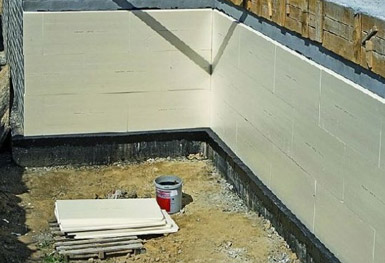 For thermal insulation of the basement walls from the outside, special boards of hard polystyrene can be used. They are glued to freshly applied bituminous waterproofing based on water. Then he covers the excavation around the foundations with a layer of well -permeable soil or gravel. These plates on the surface that comes in contact with the foundation have cut shallow grooves, which condensing moisture flows down to drainage without lying in waterproofing. The outer surface of the plates allows you to apply plaster.
For thermal insulation of the basement walls from the outside, special boards of hard polystyrene can be used. They are glued to freshly applied bituminous waterproofing based on water. Then he covers the excavation around the foundations with a layer of well -permeable soil or gravel. These plates on the surface that comes in contact with the foundation have cut shallow grooves, which condensing moisture flows down to drainage without lying in waterproofing. The outer surface of the plates allows you to apply plaster.
Enlargement of the thickness of insulation
For attic insulation, Place a layer of thermal insulation between the rafters with a thickness of at least 20 cm. Most often, the width of the rafter is smaller. So to get the necessary insulation thickness, the width of the rafters should be enlarged by nail. Another way is to nail to the sides of the special connectors dismissing the internal attic covering. Finally, you can place an additional layer of insulation between horizontal patches nailed to the rafters.
Welded felt
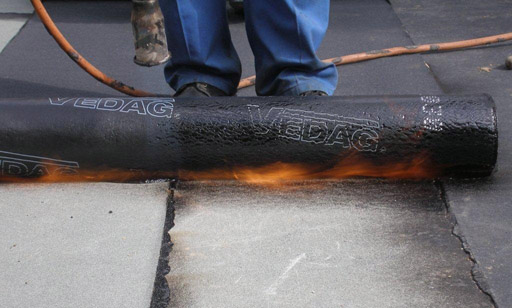 When insulating flat roofs and with a small inclination. It does not stick to the ground but only fastens with mechanical connectors along one side of the belt. Another higher lane is also mechanically fastened, and the lower edge welded to the previously arranged, with the plant 12 cm. Thanks to this, the belts can shrink and expand freely, and thus the papa does not crack like this, like other welded felt used for this type of roofing.
When insulating flat roofs and with a small inclination. It does not stick to the ground but only fastens with mechanical connectors along one side of the belt. Another higher lane is also mechanically fastened, and the lower edge welded to the previously arranged, with the plant 12 cm. Thanks to this, the belts can shrink and expand freely, and thus the papa does not crack like this, like other welded felt used for this type of roofing.
Impact
Many screws screwed into hard materials cannot be unscrewed without the use of very high force. However, you can use a stroke made of metal for this purpose. After inserting the blade of this screwdriver in an incision on the head, the screw should be strongly hit the screwdriver with the hammer. The impact will be converted to the rotational movement of the blades. The more we hit, This twisting moment will be greater. For unscrewing, you should also use a metal locksmith hammer preferably with a weight of no less than 500 g.
Blocks of blocks
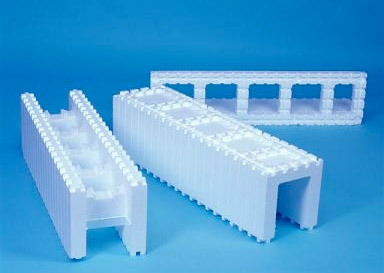 The country produces various elements creating systems for building houses made of polystyrene blocks. Simple and broken external walls are made of them, internal, as well as wreaths and ceilings. Individual blocks are connected with each other with the help of embossed locks, and then their interior fills with concrete. We get a bearing wall perfectly insulated, because the filling layer of concrete with a thickness 15 cm surround two layers on both sides – Styrofoam walls with a thickness 5-20 cm.
The country produces various elements creating systems for building houses made of polystyrene blocks. Simple and broken external walls are made of them, internal, as well as wreaths and ceilings. Individual blocks are connected with each other with the help of embossed locks, and then their interior fills with concrete. We get a bearing wall perfectly insulated, because the filling layer of concrete with a thickness 15 cm surround two layers on both sides – Styrofoam walls with a thickness 5-20 cm.
Protection of concrete
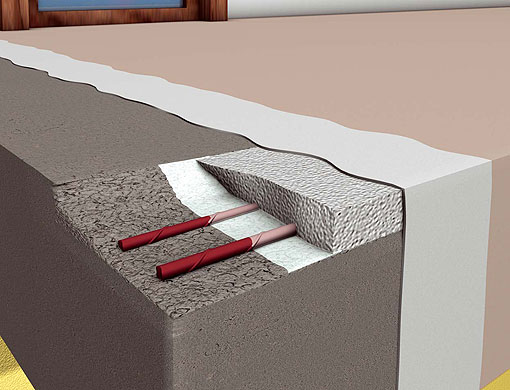 Morturous concrete requires protection. We must protect it from both frost and too heat during which the moisture necessary to bind cement is evaporated. Therefore, during the period of expected frosts, the surface of the concrete should be covered with straw or reed mats, and in the summer with thick gardening or construction foil. Periodically, you also need to sprinkle the concrete with water in the summer. With a small amount, but even 2-3 times a day, Especially in the period of strong heat.
Morturous concrete requires protection. We must protect it from both frost and too heat during which the moisture necessary to bind cement is evaporated. Therefore, during the period of expected frosts, the surface of the concrete should be covered with straw or reed mats, and in the summer with thick gardening or construction foil. Periodically, you also need to sprinkle the concrete with water in the summer. With a small amount, but even 2-3 times a day, Especially in the period of strong heat.
Mounting plasterboard
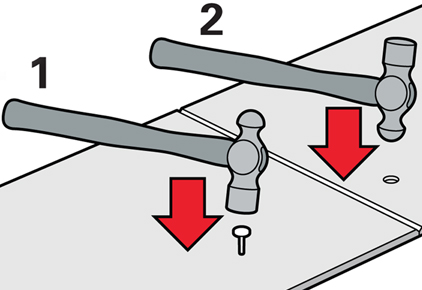 Plasterboard is screwed to the structure of tin profiles or nail with kissed nails to wooden structures. In both cases we must remember, that nail or screw heads should be distant 15 mm from the edge of the plate. However, that's not all. It is very important, To fix the screw or nail in this way (screw), to press the cardboard box slightly hiding in it. He cannot protrude beyond the face of the disc, nor be too deeply hidden, so much that it will break the cardboard.
Plasterboard is screwed to the structure of tin profiles or nail with kissed nails to wooden structures. In both cases we must remember, that nail or screw heads should be distant 15 mm from the edge of the plate. However, that's not all. It is very important, To fix the screw or nail in this way (screw), to press the cardboard box slightly hiding in it. He cannot protrude beyond the face of the disc, nor be too deeply hidden, so much that it will break the cardboard.